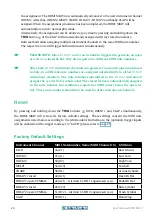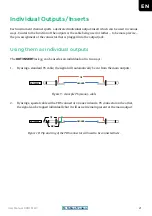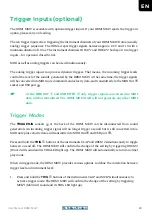
Sound Generation
Now that you have carefully unpacked and set up the DRM1 MKIV, let’s have a closer look at it. Sorry
for bothering you with mainly theoretical and safety blurb. This is a necessity to get the most out of
this unit in a creative and musical way (and to avoid nasty accidents). Well then, let’s find out what
the DRM1 MKIV really is all about!
The DRM1 MKIV is a sound module, specialized in the creation of synthetic drum sounds that are
produced by real analog circuitry. It allows the creation of eight independent drum and percussion
sounds. Even though these sounds carry the component terminology of a traditional drum kit, these
are nothing but approximations of the real thing. However, this is fully intentional. Synthetic or
analog drums have their own individual character and aesthetics. These sounds have significantly
influenced various musical genres, if not spawned them at all. Neither old-school Hip-Hop or
Electro, nor House or Techno would have been possible without the aid of those famous analog
drum machines, invented by our friends from Japan.
The DRM1 MKIV has a lot to offer. It covers many aspects of those classic units but still, there is a
lot more to it. One thing can certainly be claimed: The DRM1 MKIV is all original-sounding and not
a clone, trying to reproduce eight or nine classic sounds.
Let’s have a look at the individual drum sounds, referred to as instrument channels in the course of
this manual. While we are at it, we will also toy around with some possible applications.
All eight instrument channels of the DRM1 MKIV share the same three components:
TRIG
This button manually triggers the sound of the respective instrument channel.
Here, volume level is constant and corresponds to the level of maximum MIDI velo-
city. Note: Instrument channels HI HAT 1 and HI HAT 2 offer an additional choice of
sounds (see “HI HAT 1/HI HAT 2” on page 16).
PAN
This control adjusts the position of the individual instrument channels within the
stereo panorama when using the main
o
and headphone outputs
u
. Note that
PAN
has no effect on the individual outputs
t
of the instrument channels.
VOLUME
This control adjusts the volume of the individual instrument channels for the main
o
, headphone
u
and individual outputs
t
.
☛
For achieving the best signal-to-noise ratio possible, we highly recommend you to
set the
VOLUME
knob
t
of the instrument channels as high as necessary (around
approx. 1 – 2 o' clock) while setting the
MASTER
control
y
as low as possible.
User Manual DRM1 MKIV
10
Summary of Contents for DRM1 MK4
Page 1: ...USER MANUAL DRM1 MKIV...





































